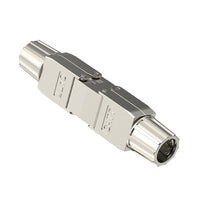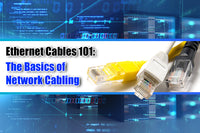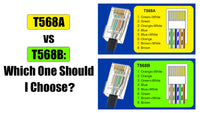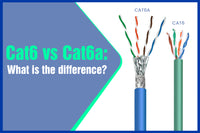Contents
We mainly use twisted paired Ethernet cables in our daily network installation, but do you know that Ethernet cables can also be divided into solid and stranded types? The differences in the conductor can largely influence the cable performance. If you’re unsure where and when to use these Ethernet cables, this blog can help you. Using solid or stranded Ethernet cable depends on many factors, including the environment, application, and price. Let’s dig it out.
Solid Ethernet Cable

As the name explains, the solid Ethernet cable is a network cable with a solid conductor in each cable wire. The diameter of solid Ethernet cables typically ranges from 22AWG to 24AWG. Solid Ethernet cables have larger wires that can keep them stable even in harsh environments. So, solid Ethernet cables are often used in high-speed data transmission applications such as data centers and server rooms.
Stranded Ethernet Cable

Stranded Ethernet cables are rarely seen on the market, but they are also frequently used in the manufacture of Ethernet patch cables. Each conductor of the stranded cable is made of a bundle of small-gauge wires twisted with each other, and the core wire is often surrounded by several wires. Stranded Ethernet cables are usually smaller than solid ones and preferred by people for their flexibility. The specification of stranded Ethernet cable contains 2 numbers (one for the number of strands and the other stands for the gauge of wires).
Solid vs. Stranded
Performance
The significant advantage of solid Ethernet cables is that they can run longer distances with less data loss. It is known that higher-gauged wires have a higher signal loss (attenuation) than lower-gauged wires and stranded Ethernet cables have more attenuation than the solid ones. Moreover, stranded conductors have small gaps between each wire, which will also cause data degradation over a long distance.
Solid cables feature thick copper wire, so they are stiff enough to run through the concrete wall. Solid cables are more resistant to corrosion, abrasion, and impact than stranded cables. People prefer to use solid cables for their durability as they don’t need to frequently replace the cable.
Solid copper is also a greater conductor and less sensitive to high-frequency environments than stranded ones.
Flexibility
Stranded cables are more flexible than solid cables for their thinner wires, making them very suitable for short-distance network installation in a room or office. Stranded Ethernet cables can withstand frequent and great bending, which is ideal for situations where cables are often moved around. Stranded cables are often used in patch panels, wall plates, and user’s end equipment.
Compatibility
Ethernet cables should be terminated for network installation and the construction of Ethernet cables also influence the termination. In general, contact pins in RJ45 connectors, IDCs on keystone jacks, and punch down tools are designed for solid cables. So a stranded Ethernet cable may be difficult to terminate with traditional IDC jacks and punch down tools. What’s more, they may be easy to break and become loose over time.
Cost
Stranded Ethernet cables can be more expensive than solid cables. The number of strands affects the cost of cable and an Ethernet cable with more strands can be more expensive. To reduce the cost, stranded CAT6 and CAT6A cables are designed to maintain flexibility with a suitable number of strands that won't largely increase the price. But it should be noted that if an area requires greater flexibility and environmental control, you should never replace the stranded Ethernet cables with solid ones.
Which One Should I Choose?
Stranded and solid Ethernet cables are designed for different scenarios. Solid Ethernet cables may be more common than stranded ones on the market, but stranded Ethernet cables are designed for specific situations.
Stranded cables are commonly utilized for patch cables as they may experience signal loss over longer distances. They are often designed for short runs, especially the final 10 meters of your network. For example, you will find many stranded Ethernet cables between your computer and network switches. The flexibility makes stranded Ethernet cables suitable for tight places where they may often be bent. In addition, these cables are well-suited for applications requiring frequent plugging and unplugging.
Tips: There is a special situation for open office environments where the standard allows for more than 10 meters of stranded patch cord within a 100-meter channel because the office environments require a more flexible cabling system.
When it refers to horizontal and backbone cable runs, solid Ethernet cables are definitely the only choice. Solid cables are the ideal choice for permanent wiring applications where minimal movement or manipulation of the cable is needed. In addition, solid Ethernet cables come in different cable jackets for various scenarios so that they can be installed outdoors or underground. Different from stranded Ethernet cables, solid cables are generally used for long distance.
The other important thing is the use of PoE technology. When PoE is passed through the twisted pair copper wire, the temperature of the cable will increase. The data transmission of stranded cables can be greatly affected by higher temperature, so they cannot support PoE technology. People often use solid Ethernet cables for PoE (Power over Ethernet), offering a good platform for VoIP phones, IP cameras, and Wireless Access Points.

For more information on this topic, you can keep up on our blogs. While VCELINK offers general and basic information for our customers and other visitors to the website, it’s not professional advice.






This blogpost succinctly highlights the crucial differences between solid and stranded Ethernet cables, offering a valuable guide for anyone grappling with the decision. The pros and cons breakdown is especially helpful, making it easier for readers to weigh their options based on specific needs. Clear and concise – a must-read for those looking to make an informed choice in their networking setups!